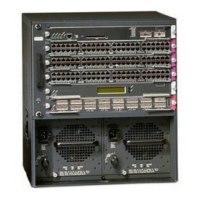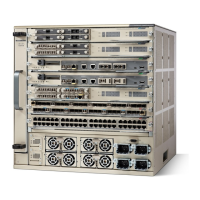8-19
Catalyst 6500 Series Switch and Cisco 7600 Series Router Firewall Services Module Configuration Guide
OL-6392-01
Chapter 8 Configuring IP Addresses, Routing, and DHCP
Configuring the DHCP Server
If you want to use both modes, then enter the rip command two times with different modes for a given
interface. For example, enter the following commands:
FWSM(config)# rip inside default version 2 authentication md5 scorpius 1
FWSM(config)# rip inside passive version 2 authentication md5 scorpius 1
If you want to enable passive RIP on all interfaces, but only enable default routes on the inside interface,
enter the following commands:
FWSM(config)# rip inside default version 2 authentication md5 scorpius 1
FWSM(config)# rip inside passive version 2 authentication md5 scorpius 1
FWSM(config)# rip outside passive version 2 authentication md5 scorpius 1
Note Before testing your configuration, flush the ARP caches on any routers connected to the FWSM. For
Cisco routers, use the clear arp command to flush the ARP cache.
Configuring the DHCP Server
This section describes how to use the Dynamic Host Configuration Protocol (DHCP) server provided by
the FWSM. It includes the following topics:
• Enabling the DHCP Server, page 8-19
• Using Cisco IP Phones with a DHCP Server, page 8-20
Enabling the DHCP Server
The FWSM can act as a DHCP server. DHCP is a protocol that supplies network settings to hosts
including the host IP address, the default gateway, and a DNS server.
Note The FWSM DHCP server does not support BOOTP requests.
Note For multiple context mode, you cannot enable the DHCP server or DHCP relay on an interface that is
used by more than one context (a shared VLAN).
The DHCP server can be enabled on any interface. Clients must be directly connected to the FWSM and
cannot send requests through another relay agent or a router.
To enable the DHCP server on a given FWSM interface, follow these steps:
Step 1 To create a DHCP address pool, enter the following command:
FWSM/contexta(config)# dhcpd address
ip_address
-
ip_address
interface_name
The FWSM assigns a client one of the addresses from this pool to use for a given length of time. These
addresses are the local untranslated addresses for the directly connected network.
The address pool must be on the same subnet as the FWSM interface.

